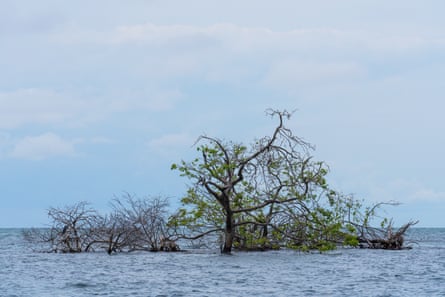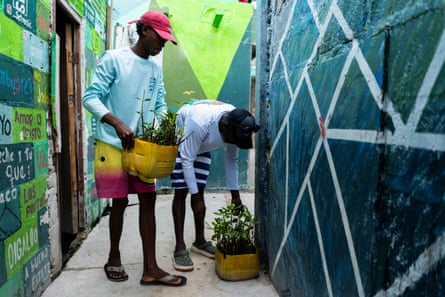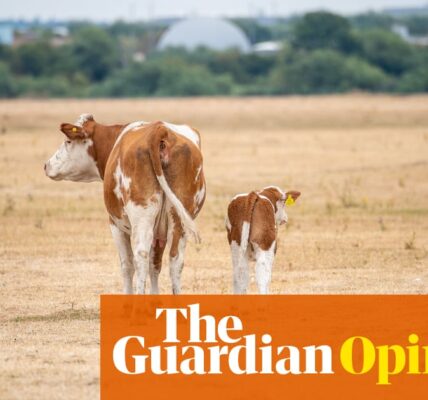“Is it too late for the disappearing Colombian islands of San Bernardo? ‘Our only option is to flee,'” lament local residents.
P
Residents of the small Colombian island of Santa Cruz del Islote are accustomed to being awoken by the peaceful sound of waves. However, this seemingly idyllic noise can actually be unsettling and disruptive.
As islanders awaken and step out of bed, they can feel the wetness on their feet and realize that their homes have once again been submerged.
Santa Cruz del Islote, part of the San Bernardo archipelago, a few miles off Colombia’s Caribbean coast, is typical of many of the world’s low-lying coastal regions now at the forefront of the escalating battle against the climate crisis.
Adrián Caraballo, a young islander and local climate activist, expresses deep concern over the rising tides and sea levels that are causing flooding and threatening the existence of island homes. He fears that their islands may eventually disappear.
Caraballo remembers walking through water that reached up to their ankles on the streets during a recent flood on Santa Cruz del Islote, which is known as one of the most densely populated islands in the world.

The group of 10 small islands in the archipelago is located within a preserved natural park and is inhabited by approximately 1,500 individuals. These islands are surrounded by an elaborate network of coral reefs and a thick tangle of mangroves, with an average elevation of only 2 meters above the water’s surface.
Sea levels are projected to increase by 30cm by 2050, posing a threat to the survival of the people of San Bernardo and potentially leading to the disappearance of the islands.
The inhabitants of this area rely on traditional fishing and tourism for their livelihood. Some of the islands in the archipelago have already vanished due to increasing sea levels, while the remaining ones are facing challenges such as erosion and shifts in ocean temperatures, acidity, and marine life diversity caused by the climate emergency. These factors are depleting the fish population, which is crucial for the local economy and sustenance of families.
Juan Manuel Díaz, the director of Fundación MarViva Colombia, a regional conservation group, expresses dismay over the loss of not only human life, but also a valuable ecological heritage. He reflects on how much has changed in San Bernardo, which he knew four decades ago.

The fate of Maravilla Island serves as a stark reminder of the archipelago’s predicament. Once known among locals as “Bird Island”, because of its flocks of migrating frigates, albatrosses and pelicans, the one-hectare (2.47 acre) islet was granted state protection for “its conditions to be preserved in perpetuity”. Yet it had vanished by 2017, swallowed by rising seas. Now it is nothing more than a snorkelling spot for tourists.
Previous alerts had been issued, stating that the islands of Carivanita and Pérdida had allegedly vanished approximately 60 years ago, as stated in a study conducted in 2019.
According to conservationists and scientists in the area, Maravilla will not be the only one to disappear in San Bernardo. “Unfortunately, the future of these islands is one of disappearance,” says Díaz.

The islands of Ceycén and Panda are at risk of being submerged within the next decade, causing concern among the residents. Panda Island was previously divided in half due to the encroaching waters and the deterioration of its mangrove forests.
The biggest island in San Bernardo is Múcura Island, which is currently facing the challenges of the climate crisis. The area experiences frequent flooding, posing a threat to the primary school that educates approximately 30 students.
Move on from advertising the newsletter.
after newsletter promotion
For many years, concerned residents of the island have been worried about the security of the school. Its base has previously crumbled, causing concern that it may happen again.
In San Bernardo, coastal erosion is now a pressing concern. Múcura boasts the largest tourist facilities, with numerous hotels scattered along a shoreline that has been steadily shrinking. Harsh winds, increasing tides, and the careless cutting down of mangroves – essential for guarding the coast – have hastened this deterioration.
In 2014, a report from the local government stated that approximately 45% of San Bernardo’s coastlines have been impacted by erosion. The report also predicts that by 2040, 22% of Múcura will be flooded. However, there has been no new information since the study was conducted nine years ago.
According to Sandra Vilardy, a well-known ecologist and former Colombian vice-minister for the environment, the economic problems faced by small islands are greatly influenced by the climate crisis. This is due to the potential impact on food fishing and coral reefs, which could have a profound effect on both food and physical security for the island’s inhabitants.
The islands are vanishing right before our eyes, and both locals and experts in science and the environment are blaming the government for disregarding the issue. They are concerned that it may be too late to rectify the situation.

San Bernardo is currently experiencing an administrative stalemate. While it falls under the control of the state’s natural parks authority, it is governed by the city of Cartagena, which is located 48 miles away.
According to Díaz, there is no action being taken and no authority is addressing this issue seriously. The presence of these individuals in San Bernardo goes against the park authority’s conservation goals, but it is also not their responsibility to address social issues.
According to Vilardy, the islands are being hindered by administrative inefficiency. However, she acknowledges that it is challenging to prioritize these issues at the state level. The Ministry of Environment is responsible for creating policies but has no authority to take action.
According to her, in isolated regions like San Bernardo, the local authorities face more challenges due to the fact that their jurisdiction is primarily based on the mainland. This makes it difficult for islands and archipelagos to effectively integrate into public administration.
Local residents’ efforts to combat the looming climate crisis have clashed with the environmental regulations enforced by park authorities, as they are believed to disrupt the protected landscape of the park. However, many islanders claim they have no other option but to construct basic shell barriers to protect against the encroaching waves. Others have resorted to using concrete walls.

Caraballo, an advocate for the environment, is among the individuals who have turned to replanting a significant number of damaged mangroves in an effort to aid the islands in their fight against increasing sea levels and diminishing shorelines.
“We must reduce the impact by planting mangroves. If we received support from the government, we would witness an enhancement of the islands or some form of restoration. Unfortunately, we do not have access to such support,” he states.
As the issue of climate change continues to intensify and the global community faces challenges in meeting its environmental obligations, Caraballo maintains optimism for a potential resolution. However, some have a more pessimistic perspective. According to Díaz, “In the end, there is no option but to flee.”
We must create an evacuation plan. We have sufficient time to develop it gradually before a disaster occurs.
Source: theguardian.com



